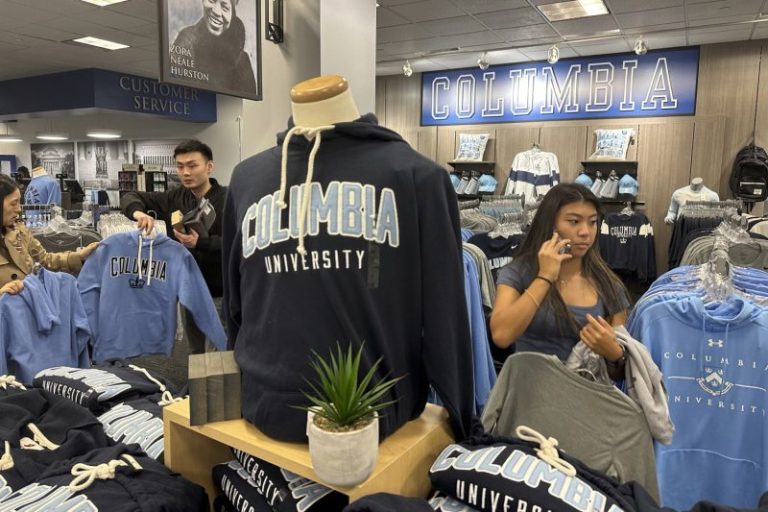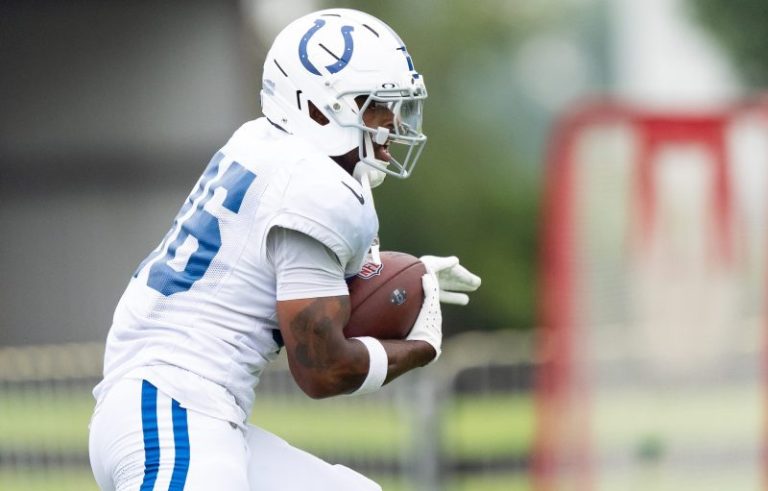There was already one night of wild action. The second one was just as good.
WWE capped off its double-day SummerSlam 2025 on Sunday, Aug. 3, and it was a massive night with heavy consequences on the business as all six matches were for championships. Plenty of chaos happened with tables, ladders and chairs involved in the six-team tag team match and no disqualifications in the Women’s Intercontinental Championship and United States Championship matches.
But the headliner of the weekend was the WrestleMania 41 rematch between John Cena and Cody Rhodes in a street fight. The WWE universe got the old Cena back and it was an instant classic between two of the biggest stars. The finish was spectacular, but it’s what happened after the match that has raised the eyebrows of the wrestling world.
Watch: SummerSlam 2025 post-show
Brock Lesnar returns
The Beast is back.
After Cena gets a standing ovation from the crowd, Brock Lesnar emerges for his first WWE appearance since 2023. He enters the ring and delivers an F-5 to Cena.
Street fight for the Undisputed WWE Championship: John Cena (c) vs. Cody Rhodes
With the real Cena back, the two faces of generations stood toe-to-toe and Cena actually hugged Rhodes. They shared some words before they immediately got to work, wasting zero time getting the action started outside of the ring.
Cena went up to Tyrese Haliburton and took his crutches to use as a weapon to hit Rhodes. He almost had the AA ready to go, but Rhodes got out and slammed the champion on the steel steps. No side was able to get much of an advantage with brutal shots being traded in quick fashion.
After absorbing chair shots, vintage Cena came out with a Five-Knuckle Shuffle, but he wasn’t able to land the AA. Rhodes responded with a bionic elbow into a Cody Cutter, and the pin attempt was unsuccessful. Rhodes tried to pick Cena back up when he surprised him with an AA, finally landing it. But Rhodes kicked out of the pin. Several signature moves followed with pin attempts, all of which were kicked out of.
Cena delivered another AA after taking a piledriver that left both star lying in the ring. When they both got up, they traded shots as the crowd was clearly rooting for Cena. Rhodes executed a powerbomb, but Cena turned it into the STF submission. Rhodes’ only chance to break it was to bounce Cena off the ring. Outside of the ring, Cena showed he has plenty in the bag when a Pop Rox-esque maneuver.
The champion cleared off the announcer’s table and brought Rhodes up for a flying AA. He brought Rhodes back in the ring for a pin attempt that Rhodes kicked out of. Cena tried to get going again, and Rhodes got out of the way and executed Cross Rhodes. Cena kicked out of the following pin. After delivering a flying leg drop and AA, Cena was unable to secure the win.
A table was brought into the ring by Cena but Rhodes got out of another punishing AA. The action then went into the crowd and backstage, with the competitors using the environment to their advantage. Cena had the advantage and carried Rhodes back into the ring, who got up quickly and threw Cena into a table. He hit the Cross Rhodes, and Cena kicked out.
Rhodes loosened out of the turnbuckles and used it as a weapon. Cena got up and Rhodes did it again as he looked to be battling his decision-making. He tried it a third time, but Cena dodged it and turned it into an STF with the rope. It didn’t last long and Rhodes turned it into three consecutive Cross Rhodes. The finisher was done, but Cena stunningly kicked out.
The challenger was desperate, and he grabbed the title, ready to end it the same way he lost at WrestleMania. He missed, and Cena landed two straight AAs before he went to the top turnbuckle for a super AA. It looked to be the finishing touch, and somehow Rhodes kicked out.
Cena tried another super AA with a table placed in the ring. Rhodes got down and then climbed up for a flying Cross Rhodes. Cena was stunned and Rhodes saluted Cena before delivering one last Cross Rhodes. It was enough, and Rhodes reclaimed the Undisputed WWE Championship.
After the match, Cena got up and gave Rhodes the title before giving him some words that made the new champion emotional.
Analysis: What a beauty.
For most of the year, Cena’s matches haven’t been great, leaving fans to wonder if his greatness was long gone. But the attitude adjustment was really needed and it completely overhauled his in-ring ability, delivering another signature match in his decorated career. Seeing two big-time names just go to complete war against one another and just throw everything they can at each other was entertaining. The crowd was buzzing the entire time, and it felt like a massive apology for WrestleMania 41.
Losing the title means Cena will get to focus on finishing his career on a high note, and it’s evident he has an opponent awaiting for him in Lesnar. The fans are fully behind him again, and it should make a spectacular final four months.
The real Cena showed up and delivered not just his best match of his farewell tour, but one of the top matches of 2025.
John Cena brings back iconic entrance
The real Cena is back. The titantron and hyped up champion returns, as well as the signature run to the ring.
Cody Rhodes entrance includes words from father, Dusty Rhodes
Before ‘The American Nightmare’ emerges, a speech plays from his father, the late Dusty Rhodes.
SummerSlam attendance
Stephanie McMahon announces the attendance for night two at 60,561. Combined with night one, the total attendance of the first-two day SummerSlam is 113,722, easily making it the biggest SummerSlam in WWE history.
Intercontinental Championship match: Dominik Mysterio (c) vs. AJ Styles
It took one powerful punch from Styles to get Mysterio running away, seeing an extremely confident challenger in the ring. Mysterio needed to avoid Styles until he saw a window of opportunity to get on offense and get his swagger back.
Like most of his matches, Mysterio’s cockiness was getting the best of him in letting opponents get back in the fight. Styles was showing off his veteran experience in the ring, countering Mysterio. But when Styles tried a frog splash, Mysterio got his knees up. The champion got up and set up the 619, which he executed. All that was needed was the frog splash, but Styles got his leg up to prevent the loss.
After throwing Styles into the corner, he untied one of the turnbuckles and forced the referee to fix it. He then brought the chair into the ring and tried the Eddie Guerrero ‘lie, cheat and steal’ playbook to make it seem like he got hit. But Styles knew what he was doing and he pretended he got hit to avoid the loss in a great callback to the WWE legend.
Styles was able to get the Cab Crusher submission to Mysterio, but he took off his boot. He then got shoved by the referee and with the official not looking, used his boot to hit Styles in the heat. It knocked him out, and he climbed up for the frog splash to retain the championship.
Analysis: The build-up to this match has been pure comedy and the two stars dipped into it to deliver a fun penultimate match. It wasn’t going to be a five-star classic, so the competitors needed to bring some juice to the ring. Both sides paying respect to Eddie Guerrero was a nice tribute given the impact he had on the stars.
Mysterio ensures some success for The Judgment Day after they lost the Women’s Tag Team Championship a day prior. His reign has been sort of a dud, but it does help getting a win over a highly respected performer like Styles. Since it feels like the clock is ticking on Styles’ career, it wouldn’t be bad to see a rematch of this.
AJ Styles arrives in low rider, pays homage to Eddie Guerrero
Styles has a tribute to Eddie Guerrero facing Dominik Mysterio. He enters the match in a low rider and does Guerrero’s signature emotes. His gear also mimics Guerrero and has a shirt that reads ‘Styles heat.’
Steel cage match for United States Championship: Solo Sikoa (c) vs. Jacob Fatu
Fatu was rolling inside the steel cage early, but Sikoa showed it wouldn’t be a one sided affair. He recovered and actually put up an impressive offensive performance that really had the challenger down. Sikoa ordered the door be open she he could win, but Fatu held his feet to prevent him from winning the match. He tried to officially put Fatu away with a Samoan Spike, only for Fatu to dodge it and get back on offense.
Sikoa was thrown around the steel cage and Fatu was really feeling it with back-to-back moonsaults to his cousin. Fatu opted to go for the pin and Sikoa kicked out, and that’s when the rest of MFT came out to circle the ring. But reinforcements came with Jimmy Uso trying to help out, just for him to get thrown around by Talla Tonga. Inside the ring, Sikoa recovered to execute the Samoan Spike, and Fatu kicked out of the subsequent pin attempt.
Understanding a pin was going to be tough, Sikoa climbed the steel cage to try to win. When he got to the top, Fatu met him and brought him back in. MFT climbed into the ring and Tonga handcuffed Fatu to the cage, paving the way for Sikoa to win. JC Mateo opened the door for him, but Fatu somehow got out of the handcuffs and stopped the champion. He was about to drag Sikoa out when Tonga used the door to hit Fatu. It knocked him out, and Sikoa crawled out for the win.
After the match, Uso threw Mateo in the ring and Fatu assaulted the MFT members still in there. Fatu climbed to the top of the cage and landed a high-flying moonsault to take down Mateo and Loa.
Analysis: With Fatu in a steel cage, it had the potential to be a wild match. However, the match feels like it wasn’t able to fully deliver. There was a chance to have some great spots and given how the night has gone, it was expected to have wow moments. But it didn’t happen, and Fatu didn’t deliver until after the match was over.
With Sikoa thriving in his new group, he needs the title to establish themselves as a force to be reckoned with. It was obvious his group was going to come out and help, it was just a matter of how it was going to work. The ending however showed Fatu isn’t done with MFT just yet, and there’s likely one more bout awaiting him and Sikoa before it’s time to move on.
No disqualification, no count out match for Women’s Intercontinental Championship: Becky Lynch (c) vs. Lyra Valkyria
The challenger had an aggressive approach to the night in what could be her final shot at Lynch, and when the action went out of the ring, Lynch had a kendo stick but Valkyria had a crow bar. Neither were able to land hits that would’ve quickly ended the match, but Valkyria had Lynch out of sorts, throwing her over the announcer’s table.
While setting up a table, Valkyria was surprised by Lynch as the champion wrapped a steel chain around her mouth and followed it with a throw into the steel steps. Valkyria rolled back in the ring and Lynch delivered several shots with a kendo stick, including one with an Aaron Judge impersonation.
Lynch brought more weapons into the ring, using a chair and a loaded tool box to her advantage. Despite all the hits, Valkyria still kicked out. Frustrated, Lynch brought out a zip tie to put Valkyria’s hands together while she used a wrench as a weapon. Lynch then had her propped up on the turnbuckle and delivered shots with the kendo stick to her midsection. Still, Valkyria was hanging on, kicking out of pins.
A Manhandle Slam nearly put Valkyria away until the challenger was able to get herself tangled with Lynch and pause the momentum. She showed some fight despite her hands still tied together when she suddenly disappeared. Lynch didn’t know where she was, and she went to check under the ring, she was met with a fire extinguisher from Valkyria. She finally freed her hands from the zip tie and was finally able to repay the favor with the kendo stick. Back outside the ring, Valkyria executed a Nightwing on the steel steps.
Valkyria brought Lynch back into the ring when ‘The Man’ moved out of the way to let Valkyria hit the exposed turnbuckle. She then landed the Manhandle Slam on the steel chair, but Valkyria somehow kicked out of the pin. The champion was puzzled, and kept the assault going by putting Valkyria in between a steel chair and ramming her into the announcer’s table.
Lynch had the crowbar in hand and was about to hit Valkyria with it when Bayley came out and stopped her. The champion tried to tell Bayley to do it instead and she contemplated it. She didn’t go through, and delivered hits to Lynch, driving her into the barricade. By the time Lynch got out of Bayley’s way, she was met with a flying leg drop by Valkyria through the table.
Both stars were gassed and tried to finish the bout in the ring. But Bayley came back in and was about to hit Lynch with the steel chain. Lynch avoided it, and Valkyria instead took the hit. Bayley didn’t believe it, and Lynch capitalized with a Manhandle Slam to end it and keep the title.
Analysis: What a final match these two put on in a rivalry that has brought out the best out of each star.
The heat had been rising between Lynch and Valkyria for months and it was a brutal close. They didn’t hold anything back in the no disqualification match, and it was actually a surprise to see it play out in a longer bout than expected. It goes to show if given the time, they can put on an incredible product. Bayley’s involvement was inevitable, it was just a question of who it was going to benefit. Turns out, the champion got help, even if it wasn’t intended.
Lynch finally puts Valkyria past her, and it’s looking like she’ll get that feud with Bayley for the title in a meeting of veterans. While she lost, Valkyria has shown she has main event potential in this feud, and it may be awaiting her in the coming months.
Becky Lynch debuts new entrance music
It’s a new walkout for the decorated star by The Wonder Years.
Six-team tables, ladders and chairs match for WWE Tag Team Championship
Given how much havoc The Wyatt Sicks have caused, the five challenging teams targeted Joe Gacy and Dexter Lumis out of the gate before turning attention to each other. From there, the chaos began with bodies flying all around the ring and weapons being used to deliver some punishing blows. The Street Profits and the team of Andrade and Rey Fenix had some of the early top moments.
The first attempts to climb the ladder were unsuccessful as the momentum rotated between all of the teams, and the hits only got harder. Johnny Gargano delivered a spinning DDT to Gacy to start a chain reaction of high-risk maneuvers, capped by Axiom executing a Spanish Fly of Angelo Dawkins in a spectacular sequence.
With no disqualification, some of the teams’ partners in Candice LeRae, B-Fab and Nikki Cross got involved, hoping to be that extra help to secure a win. LeRae tried to climb the ladder to aid her husband’s team, but she got accidentally pushed off and fell onto another ladder out of the ring in a stunning spot.
Montez Ford’s reaction said it all.
Erick Rowan then got in the mix to stop The Street Profits, but the veteran team was ready to deal with the powerful force. Tommaso Ciampa climbed the ladder and had his hands on the titles, but the ladder was moved and he was left hanging onto it. Nathan Frazer tried to knock him down but the core strength of Ciampa helped him avoid it while still hanging.
There was a scramble on top of two ladders until Uncle Howdy came and pushed everyone off, sending #DIY through a stack of tables out of the ring. Nathan Frazer received a mandible claw from the leader of The Wyatt Sicks, and Andrade came and delivered a sunset flip powerbomb to Uncle Howdy.
Rey Fenix was alone but the reigning champions came back in and handled him. Gacy and Lumis were all alone and Gacy climbed the ladder to retrieve the titles and keep the gold with The Wyatt Sicks.
Analysis: We knew it was going to cook. We got exactly what we expected.
Plenty of chaos was in store for this wild match and every star left it out in the ring to deliver a match that was blowing everyone’s minds from the moment it started all the way to the end. Nothing was off limits as each person got the chance to deliver a stunning shot. By far the most entertaining match of the weekend, and a reminder that the tag team division has so many talented groups that deserve the spotlight. What’s amazing is the MVP of the match was Candice LeRae, who took the bump of the weekend falling down the ladder.
A case could’ve been made for every team to win, but The Wyatt Sicks’ numbers advantage was going to play a roll in. The team has been on a hot streak ever since it returned from hiatus, and it’s helped make them a formidable tag team faction that Bray Wyatt envisioned. With the win, The Wyatt Sicks continue to reign supreme and make it tough for the rest of the division to figure out how to knock them down from their pedestal.
Women’s World Championship match: Naomi (c) vs. Iyo Sky vs. Rhea Ripley
The champion wasn’t interested in getting involved at the start, but the challengers forced her into action and formed a brief alliance. It backfired quickly when Ripley inadvertently delivered a boot to Sky, allowing Naomi to get the upper hand. It didn’t matter which star was in front of her, Naomi was putting on a clinic.
Feeling the momentum, Naomi started to taunt Sky and that’s when it didn’t work in her favor. Sky and Ripley teamed up again to attack the champion, and the challengers celebrated with Sky’s signature emote. They threw Naomi out of the ring and the two stars continued their bout from Evolution. It was a back-and-forth sequence after that with Ripley and Sky doing what they do best. While that was going on, Naomi was breaking up pinfall attempts.
Sky was rolling after she took out the competition with a springboard fly out of the ring and she readied the Over the Moonsault, but Ripley tripped her up. Naomi brought Ripley down and was in the process of a pin while Sky came flying down for her finisher. Naomi recognized it and moved out of the way to let Ripley take the hit. She tried a roll-up on Sky that nearly worked. The champion delivered a flying knee to Sky, but turned around and was given a Riptide by Ripley. The title was ready to change hands until Sky came in to break the count as all the stars laid on the mat.
Ripley and Sky were the first to their feet as they traded shots and the action went out of the ring. Ripley landed a dive on Naomi, and Sky turned a powerbomb of Ripley onto Naomi. Sky tried to bring Ripley in the ring for her finisher, only for Sky to once again meet her on the top turnbuckle. She landed an avalanche Riptide and tried to pin Sky. However, Naomi ran in just in time and rolled up Ripley. It caught her off guard, and the referee counted to three as Naomi retained her title.
Analysis: The women kick off another premium live event and again they set the bar high for the rest of the night. It’s a given when Sky and Ripley are in the ring it’s going to be a banger, the question was how would Naomi fit into it. The challengers did a great job continuing to show the respect and admiration they have for each other, while remembering at the end of the day, it’s about getting the gold. Naomi blended into the match in being a common enemy, and she definitely showed she belonged in there.
While Sky and Ripley have put on performance recently worthy of titles, it’s too early to take the gold off Naomi. This has been such a hot run for her, and she deserves to see this get played out for at least a few months. The sneaky victory keeps the door open for Sky or Ripley to continue to challenge for the championship, which is likely the next step in Naomi’s growth in solidifying her reign with one-on-one victory.
Naomi makes entrance with father
It was a special entrance for the Women’s World Champion. Her father, Shawn McCarey, played guitar as she made her way down the ring, sharing the special occasion together.
Paul ‘Triple H’ Levesque kicks off show
WWE’s chief content officer gets the crowd ready for day two, promising a big night.
‘You ain’t seen nothing yet,’ he said.
Druski intro starts SummerSlam night two
When is SummerSlam 2025?
SummerSlam 2025 Night 2 is on Sunday, Aug. 3.
SummerSlam start time 2025
SummerSlam starts at 6 p.m. ET. The SummerSlam preshow begins at 3 p.m. ET.
Where is SummerSlam 2025?
The event takes place at MetLife Stadium in East Rutherford, New Jersey, home stadium of the NFL’s New York Giants and New York Jets.
How to watch SummerSlam 2025
SummerSlam will stream on Peacock, but you must have their premium or premium-plus subscription to watch. Internationally, it will be available on Netflix in most markets.
SummerSlam 2025 will also be available to watch at select Regal Cinemas theaters around the country. Tickets to see WWE SummerSlam in theaters are available on Fandango’s website.
SummerSlam 2025 preshow: how to watch
The SummerSlam preshow will be available to watch on Peacock, and on WWE’s social channels, including YouTube.
Stream WWE SummerSlam on Peacock
SummerSlam 2025 match card Night 2
Matches not in order
- Tables, ladders and chairs match for WWE Tag Team Championship: The Wyatt Sicks (Dexter Lumis and Joe Gacy) (c) vs. #DIY (Johnny Gargano and Tommaso Ciampa) vs. The Street Profits (Montez Ford and Angelo Dawkins) vs. Motor City Machine Guns (Alex Shelley and Chris Saban) vs. Fraxiom (Nathan Frazer and Axiom) vs. Andrade and Rey Fenix
- Steel cage match for United States Championship: Solo Sikoa (c) vs. Jacob Fatu
- No disqualification, no count out match for Women’s Intercontinental Championship: Becky Lynch (c) vs. Lyra Valkyria
- Intercontinental Championship match: Dominik Mysterio (c) vs. AJ Styles
- Women’s World Championship match: Naomi (c) vs. Iyo Sky vs. Rhea Ripley
- Street fight for the Undisputed WWE Championship: John Cena (c) vs. Cody Rhodes
SummerSlam 2025 Night 2 match order
The matches that will start and end the night are confirmed.
WWE makes SummerSlam two nights
For the first time in its 38-year history, SummerSlam takes place on two nights.
WWE first announced the decision for the 2026 event in Minneapolis, with it joining WrestleMania as the company’s two-day extravaganzas. But in September 2024, WWE said the 2025 edition in New Jersey would be a double-night event, kickstarting the timeline early.
With SummerSlam taking over Saturday and Sunday, it allows WWE to have more matches spread across the event rather than only having less than 10. In 2024, SummerSlam had just seven matches, and in 2025, it will have 12.
SummerSlam returns to New York area
It’s another SummerSlam in the New York area as it will be the fourth time it takes place in East Rutherford. Counting New Jersey and New York, the area has hosted 10 SummerSlam’s already, the most of any city.
The inaugural one took place in 1988, at Madison Square Garden in New York City, and was last in the area in 2018 at the Barclays Center in Brooklyn.
SummerSlam 2025 Night 2 predictions
USA TODAY Sports’ wrestling writers predict Night 2 of SummerSlam. See the full predictions for the entire event here.
Tables, ladders and chairs match for WWE Tag Team Championship
- Jordan Mendoza: Fraxiom
- Richard Morin: Andrade and Rey Fenix
Steel cage match for United States Championship: Solo Sikoa (c) vs. Jacob Fatu
- Jordan Mendoza: Solo Sikoa
- Richard Morin: Jacob Fatu
No disqualification, no countout match for Women’s Intercontinental Championship: Becky Lynch (c) vs. Lyra Valkyria
- Jordan Mendoza: Becky Lynch
- Richard Morin: Lyra Valkyria
Intercontinental Championship match: Dominik Mysterio (c) vs. AJ Styles
- Jordan Mendoza: AJ Styles
- Richard Morin: AJ Styles
Women’s World Championship match: Naomi (c) vs. Iyo Sky vs. Rhea Ripley
- Jordan Mendoza: Naomi
- Richard Morin: Naomi
Street fight for the Undisputed WWE Championship: John Cena (c) vs. Cody Rhodes
- Jordan Mendoza: Cody Rhodes
- Richard Morin: John Cena
SummerSlam 2025 night one results
Missed what happened on night one? Here’s what unfolded on Saturday, Aug. 2:
- Roman Reigns and Jey Uso def. Bron Breakker and Bronson Reed
- Charlotte Flair and Alexa Bliss def. Raquel Rodriguez and Roxanne Perez to win WWE Women’s Tag Team Championship
- Sami Zayn def. Karrion Kross
- Tiffany Stratton def. Jade Cargill to retain WWE Women’s Championship
- Logan Paul and Drew McIntyre def. Randy Orton and Jelly Roll
- CM Punk def. Gunther to win World Heavyweight Championship
- Seth Rollins returns, cashes in Money in the Bank contract and def. CM Punk to win World Heavyweight Championship
The biggest stories, every morning. Stay up-to-date on all the key sports developments by subscribing to USA TODAY Sports’ newsletter.
This post appeared first on USA TODAY










